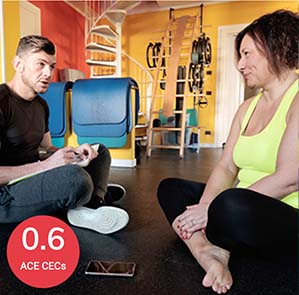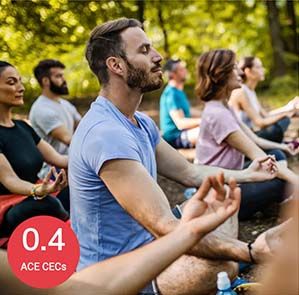
Happiness. It’s something we all want but seems to elude many.
Case in point: A happiness survey by Oracle found that 45% of people had not felt true happiness for more than two years and 25% didn’t know or had forgotten what it meant to feel truly happy.
Now, how you have experienced the past several years might determine if you are shocked by these statistics or if they sound about right. Either way, there is no question that for many people, happiness has become an elusive state, at best, or an unreachable goal at worst.
But what, exactly, is happiness? Can you get more of it or are you born with all the happiness you’ll ever have? Are happier people healthier? Can happiness be measured? And can you coach your clients toward more happiness?
Happiness is a huge subject and can’t be covered in one article, but let’s begin to explore the topic by attempting to answer these questions.
What Is Happiness?
“Happiness,” wrote the ancient Greek philosopher Aristotle, “is the meaning and purpose of life, the whole aim, and the end of human existence.” Aristotle used the term eudaimonia to express what he meant by happiness, which relates to having a purposeful, meaningful life and a relatively stable state of happiness, as opposed to a fleeting feeling of happiness.
Modern definitions focus more on the state of happiness—and our individual right to achieve it—rather than what it takes to achieve it. For example, Merriam-Webster defines happiness as “a state of well-being and contentment: JOY,” while the U.S. Declaration of Independence states that each of us has a right to the pursuit of happiness.
In the late 1990s, Martin Seligman, PhD, and colleagues initiated the positive psychology movement to study and promote what makes people happy. Unlike traditional psychology, which studies and determines what’s “wrong” with people—and then tries to “fix” it—positive psychology focuses on people’s strengths and what’s going well for them, helping them to thrive and create flourishing, meaningful lives.
Thousands of studies on happiness have been conducted over the years, and a 2023 review of the literature published in the International Journal of Environmental Research and Public Health, identified three main determinants of happiness and what they encompass:
- Health, including one’s mental, emotional and physical well-being
- Hope, which is marked by having a purposeful holistic work-life balance, nurturing social relationships and caring for self and others
- Harmony with one’s culture, traditions, community and the environment moderated by economic, social, cultural and environmental conditions that impact individual and societal happiness
In other words, a wide range of factors influence our individual levels of happiness—including our genes.
In a 2014 PLOS ONE study, researchers narrowed down a specific gene that seems to influence one’s natural tendency toward happiness. And a 2023 study in Scientific Reports suggests that brain structure—or brain phenotype—may play a role in one’s level of happiness.
“We have certain personality traits, preferences and genetic dispositions we are born with,” says Anna Katharina Schaffner, PhD, author of The Art of Self-Improvement: Ten Timeless Truths (Yale University Press, 2021). “Formative childhood experiences and attachment patterns also contribute to our general outlook on the world and how we respond to challenges.”
Maria Baltazzi, PhD, MFA, an Emmy award-winning producer and author of Take a Shot at Happiness: How to Write, Direct and Produce the Life You Want (Post Hill Press, 2023), agrees that our DNA determines part of our happiness and points to research conducted by Sonja Lyubomirsky, PhD, a University of California, Riverside, distinguished professor and happiness researcher, who pioneered the concept of one’s Happiness Set Point.
“You can look at this as a pie,” explains Baltazzi. “The biggest slice is 50% of the pie, which is your DNA. Then there is a 10% pie sliver that represents your life circumstances. The remaining 40% of the pie is [made up of] the intentional activities you do to level up your happiness.”
Baltazzi goes on to say that from her perspective, purposely and intentionally engaging in activities known to boost levels of happiness will most likely impact your life circumstances and how you view them.
“So, that 40% can become even greater,” says Baltazzi. “Then, and not to get into the weeds about epigenetics, for your genes to fully express themselves, they need to be in the right environment to fire off. That means there is a lot within our control in choosing to and becoming happier.”
How to Get More Happiness—for Yourself and Your Clients
So, what types of activities will cultivate greater, deeper happiness? Remember, we’re not talking about the fleeting kind of happiness that you get when you buy a new car—although moments of that type of short-lived happiness are also important and part of the bigger picture. For now, we’re referring to the deeper joy and fulfillment that comes with living a meaningful, purposeful life.
Coaching Tips for Achieving Greater Happiness
Here are a few more concrete tips to coach your clients so they can cultivate more happiness in their lives—and ultimately create more meaningful, flourishing lives that support them in thriving and not just surviving.
1. Practice Gratitude: Study after study shows that people who make gratitude a regular part of their lives are happier and healthier. Not only does practicing gratitude rewire the brain through neuroplasticity, but it also produces a more immediate shot of happiness by increasing the “feel good” neurotransmitters, serotonin and dopamine.
The key here is consistent practice. This can be as simple as writing down what you’re thankful for each day, including why you’re thankful for it, or practicing the Three Good Things exercise.
2. Discover Unique Strengths and Virtues: It can be easy to fall into the trap of coaching our clients to strengthen their weaknesses. This may, however, be an exercise in futility. Research shows that uncovering our strengths and building our lives on them produces more success in creating meaningful lives—and meaningful lives mean happier lives.
Start the process of discovering strengths by having your clients take the free quiz at VIA Institute on Character and then coach them on the ways they can begin using their strengths more often in their lives.
3. Use Strengths for a Greater Good: Using our strengths to serve a purpose greater than ourselves further strengthens and deepens our meaning and purpose—and ultimately our happiness. This can come in the form of volunteering our time or money toward a cause we have a connection with to providing a meal for a neighbor or friend who just had surgery. Get creative and coach your clients to look for opportunities to use their strengths to serve other people.
“We can and should strive to live fulfilling, purposeful lives,” says Schaffner. “If we live on purpose and pursue what is meaningful to us, we will experience a different kind of satisfaction. The ancients called it eudaimonia, a form of purposeful thriving or flourishing. It is a long-term strategy and a more quiet, sustainable form of well-being.”
Baltazzi notes that to cultivate more happiness in your life, you must have a desire for it. “Nothing happens if you do not have this desire, because you have no self-directed internal motivation. [Once you have this motivation], you can back up your choice with intentional activities to affect the change you want.”
Baltazzi recommends three primary activities for increasing your happiness level:
“Savoring the good…is one of the best [practices] I have learned on my journey,” says Baltazzi. “When you have a wonderful experience, savor it. When you smell a flower, savor it. When you stand at the edge of an ocean, savor it. Be in your moments and savor them for at least 20 to 30 seconds. Let them absorb into you. You do this often enough that it becomes your habit. Why? Because you are training your brain to look for the good in your everyday world. This practice helps foster a positive neural pathway.”
Schaffner agrees, and includes living on purpose and practicing gratitude and meditation or “finding time to calm your mind and connect to your feelings and core needs.”
It’s also important, says Schaffner, to do things that you love and nurture you and give you pleasure. “And,” says Schaffner, “prioritize connection.”
And herein lies one of the keys to happiness. In their book, The Good Life, based on the world’s longest scientific study of happiness, researchers Robert Waldinger, MD, and Marc Schulz, PhD, found that the number one way to create a more meaningful and satisfying life could be boiled down to one word: relationships.
“Good relationships keep us happier, healthier and help us live longer,” write the authors in their book. “Few things affect the quality of our lives as much as our connections to others.”
The link between relational connections and “the good life” is so strong that Waldinger and Schulz feel it should become part of public policy. “Because this need for connection is fundamental to a flourishing life, we believe that social fitness should be taught to children and be a central consideration in public policy right alongside exercise, diet and other health recommendations,” write Waldinger and Schulz.
But What About When Bad Things Happen?
It’s important to note that even happy people still experience suffering and tragedies. The difference is that they don’t stay in that dark place.
“It is unrealistic to expect that we will always be happy and feel only positive emotions,” says Schaffner. “When we allow ourselves to feel our emotions, we will feel all of them—the pleasant and the more difficult ones. We cannot just cherry-pick positive emotions.”
Baltazzi considers this deeper happiness on par with resilience—which means when you go through times of difficulty, you will bounce back more quickly if you have a firm foundation. “Happiness is not a fluffy word or fleeting emotion. It is, indeed, a state of being that impacts how you walk through the world.”
“Thousands of stories from the Harvard Study show us that the good life is not found by providing ourselves with leisure and ease,” explain Waldinger and Shultz. “Rather, it arises from the act of facing inevitable challenges, and from fully inhabiting the moments of our lives. It appears quietly, as we learn how to love and how to open ourselves to being loved, as we grow from experiences, and as we stand in solidarity with others through the inevitable string of joys and adversities in every human life.”
More Resources on Happiness
Highway to Your Happy Place: A Roadmap to Less Stress by Gary Sprouse, MD
Build the Life You Want: The Art and Science of Getting Happier by Arthur C. Brooks and Oprah Winfrey
The Happy Hour Podcast with Jonah Paquette, PsyD, and Supria Gill, PhD
“Use Your Strengths to Boost Happiness,” VIA Institute on Character, includes a survey to find your character strengths
“The Science of Happiness in Positive Psychology,” includes scales and surveys to measure levels of happiness
Expand Your Knowledge
ACE Behavior Change Specialist Program
Any fitness, healthcare or allied health professional who wants to effectively guide their clients to their goals will benefit from this specialization. You will gain crucial communication skills to foster effective client-coach relationships and will learn cognitive behavioral coaching to help your clients reach their potential. After finishing the program, you will own critical skills that will elevate your profile as a health or exercise professional.
Improving Wellness Through Behavior Change – Course Bundle
Effect and inspire positive lifestyle change within your clients by applying behavior change strategies. Whether you are coaching clients in chronic pain or stress management, the Improving Wellness Through Behavior Change course bundle has you covered. Learn the latest techniques and strategies to work more effectively with your clients so they can establish healthy habits that last a lifetime.
The Step-By-Step Guide to Teaching Relaxation
In this course, you’ll build an understanding of how society, work and family influence your clients’ mindsets, stress levels, and their ability to relax. Plus, you’ll gain tools to help your clients truly feel what’s going on in their bodies, so they can destress, be still and relax.
By guiding your clients toward healing and rejuvenation through relaxation, you will absolutely have a positive impact on their overall well-being.





 by
by 





